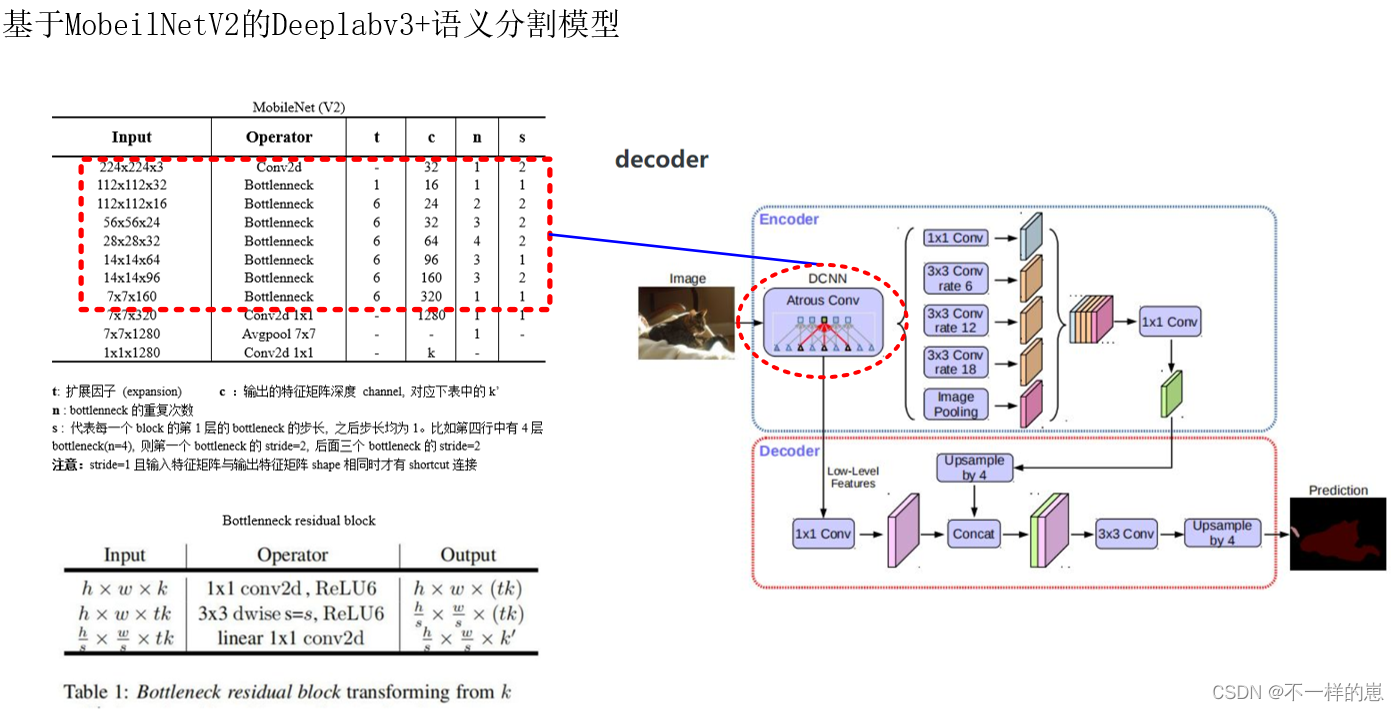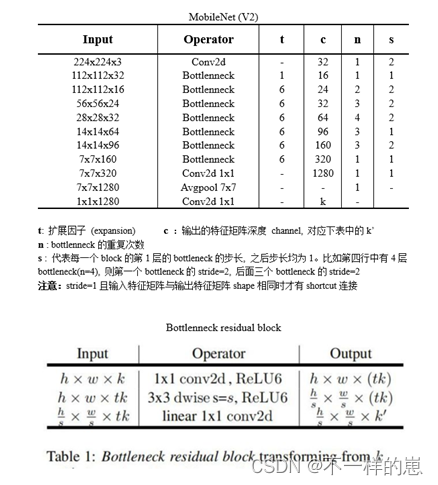目录
一. 语义分割的含义
????????语义分割是计算机视觉中的基本任务,在语义分割中我们需要将视觉输入分为不同的语义可解释类别,「语义的可解释性」即分类类别在真实世界中是有意义的。例如,我们可能需要区分图像中属于汽车的所有像素,并把这些像素涂成蓝色。

我们将 ? 图像分类,目标检测 ?和 ? 语义分割 进行对比 可以让我们更好的理解语义分割。
?图像分类: ?通过 ?提取特征,输出 待测图片趋向于某个种类
?目标检测: ? 通过 ?提取特征,输出 待测图片中不同物体的位置与种类?
?语义分割: ?通过 提取特征, 输出 待测图片的每个像素点的种类
二. DeepLabV3+ 模型

?如上图, Encoder中DCNN部分代表语义分割中的主干网络, 在本文中为轻量网络MobileNetV2
?特征提取分为高层语义提取和低层的语义提取两个部分。
????????首先 1 x 1 对通道上关联,起了一个全连接的作用,接下来是 3 个空洞卷积,有关空洞卷积参见。pooling ,然后经过 concate 将这些特征图进行组合,随后经过 1x1 卷积来改变通道大小。接下里对于底层特征图首先进行 1x1 卷积进行通道变换,这样可以拿到一些低层特征,在将上面组合变换通道数的特征图进行一次 4 倍上采样得到和低层特征图大小相同特征图后,进行组合后再进行一次 4 倍上采样。
三. 模型整体框架

????????自2017年mobile net问世之后,研究人员就不断在追求更小,更快,更准的网络模型。在这个过程中,也发现了mobile net存在的问题:1.1.结构简单,mobile net使用类似VGG的结构,这种结构已经被证明不如resnet bottle neck结构;2.depthwise convolution的输出,在relu的作用下,很容易废掉。即输出为0,且无法恢复。针对上述问题,谷歌做了改进,也即是本文的主角,mobile net v2。mobile net v2的主要改进为引入了Inverted residual block和利用线性变换替换relu。

四. 模型检测效果

五. 代码实现
MobileV2 网络代码搭建
import math
import os
import torch
import torch.nn as nn
import torch.utils.model_zoo as model_zoo
BatchNorm2d = nn.BatchNorm2d
# PW、DW -> https://blog.csdn.net/qq_41895003/article/details/107408390
# MobileNet V1、V2、V3 -> https://www.icode9.com/content-4-891085.html
def conv_bn(inp, oup, stride):
return nn.Sequential(
nn.Conv2d(inp, oup, 3, stride, 1, bias=False),
BatchNorm2d(oup),
nn.ReLU6(inplace=True)
)
def conv_1x1_bn(inp, oup):
return nn.Sequential(
nn.Conv2d(inp, oup, 1, 1, 0, bias=False),
BatchNorm2d(oup),
nn.ReLU6(inplace=True)
)
# 深度可分离卷积(Depthwise Separable Convolution)
# 一层深度卷积(Depthwise Convolution,DW)与一层逐点卷积(Pointwise Convolution,PW)组合
# 倒残差结构Block PW升维 -> DW -> PW降维
# 在 深度可分离卷积(DW + PW降维) 前加一层 PW
# rate为卷积膨胀系数 若rate>1 则为膨胀卷积(空洞卷积)
# nn.Conv2d(in_channels, out_channels, kernel_size, stride=1,padding=0, dilation=1, groups=1,bias=True):
class InvertedResidual(nn.Module):
def __init__(self, inp, oup, stride, expand_ratio):
super(InvertedResidual, self).__init__()
self.stride = stride
assert stride in [1, 2] # assert in 断言, 若stride不在[1, 2]中则报错
hidden_dim = round(inp * expand_ratio)
self.use_res_connect = self.stride == 1 and inp == oup
# --------------------------------------------#
# 深度可分离卷积
# 第一部分:DW, groups = 输出通道数 = 输入通道数, 当group = 1 时 即为普通卷积
# 第二部分:PW, 利用1×1的卷积更改输出通道数
# --------------------------------------------#
if expand_ratio == 1:
self.conv = nn.Sequential(
#--------------------------------------------#
# 进行3x3的逐层卷积,进行跨特征点的特征提取
#--------------------------------------------#
nn.Conv2d(hidden_dim, hidden_dim, 3, stride, 1, groups=hidden_dim, bias=False),
BatchNorm2d(hidden_dim),
nn.ReLU6(inplace=True),
#-----------------------------------#
# 利用1x1卷积进行通道数的调整
#-----------------------------------#
nn.Conv2d(hidden_dim, oup, 1, 1, 0, bias=False),
BatchNorm2d(oup),
)
else:
self.conv = nn.Sequential(
#-----------------------------------#
# 利用1x1卷积进行通道数的上升
#-----------------------------------#
nn.Conv2d(inp, hidden_dim, 1, 1, 0, bias=False),
BatchNorm2d(hidden_dim),
nn.ReLU6(inplace=True),
#--------------------------------------------#
# 进行3x3的逐层卷积,进行跨特征点的特征提取
#--------------------------------------------#
nn.Conv2d(hidden_dim, hidden_dim, 3, stride, 1, groups=hidden_dim, bias=False),
BatchNorm2d(hidden_dim),
nn.ReLU6(inplace=True),
#-----------------------------------#
# 利用1x1卷积进行通道数的下降
#-----------------------------------#
nn.Conv2d(hidden_dim, oup, 1, 1, 0, bias=False),
BatchNorm2d(oup),
)
def forward(self, x):
if self.use_res_connect:
return x + self.conv(x)
else:
return self.conv(x)
class MobileNetV2(nn.Module):
def __init__(self, n_class=1000, input_size=224, width_mult=1.):
super(MobileNetV2, self).__init__()
block = InvertedResidual
input_channel = 32
last_channel = 1280
interverted_residual_setting = [
# t, c, n, s
[1, 16, 1, 1], # 256, 256, 32 -> 256, 256, 16
[6, 24, 2, 2], # 256, 256, 16 -> 128, 128, 24 2
[6, 32, 3, 2], # 128, 128, 24 -> 64, 64, 32 4
[6, 64, 4, 2], # 64, 64, 32 -> 32, 32, 64 7
[6, 96, 3, 1], # 32, 32, 64 -> 32, 32, 96
[6, 160, 3, 2], # 32, 32, 96 -> 16, 16, 160 14
[6, 320, 1, 1], # 16, 16, 160 -> 16, 16, 320
]
assert input_size % 32 == 0
input_channel = int(input_channel * width_mult)
self.last_channel = int(last_channel * width_mult) if width_mult > 1.0 else last_channel
# 512, 512, 3 -> 256, 256, 32
# 对应 nets/nets.jpg中的MobilenetV2表中的第一个Conv2d
self.features = [conv_bn(3, input_channel, 2)]
for t, c, n, s in interverted_residual_setting:
output_channel = int(c * width_mult)
# 每一个blocks中包括 n个残差block, 第一个block的步长为s, 剩下的为1
for i in range(n):
if i == 0:
self.features.append(block(input_channel, output_channel, s, expand_ratio=t))
else:
self.features.append(block(input_channel, output_channel, 1, expand_ratio=t))
input_channel = output_channel
self.features.append(conv_1x1_bn(input_channel, self.last_channel))
self.features = nn.Sequential(*self.features)
self.classifier = nn.Sequential(
nn.Dropout(0.2),
nn.Linear(self.last_channel, n_class),
)
self._initialize_weights()
def forward(self, x):
x = self.features(x)
x = x.mean(3).mean(2)
x = self.classifier(x)
return x
# isinstance(x, y)判断x , y是否时相同类型 ,返回bool类型
# 例如:设置一个条件,如果m为Conv2d层就为该m添加相应的参数
def _initialize_weights(self):
for m in self.modules():
if isinstance(m, nn.Conv2d):
n = m.kernel_size[0] * m.kernel_size[1] * m.out_channels
m.weight.data.normal_(0, math.sqrt(2. / n))
if m.bias is not None:
m.bias.data.zero_()
elif isinstance(m, BatchNorm2d):
m.weight.data.fill_(1)
m.bias.data.zero_()
elif isinstance(m, nn.Linear):
n = m.weight.size(1)
m.weight.data.normal_(0, 0.01)
m.bias.data.zero_()
def load_url(url, model_dir='./model_data', map_location=None):
if not os.path.exists(model_dir):
os.makedirs(model_dir)
filename = url.split('/')[-1]
cached_file = os.path.join(model_dir, filename)
if os.path.exists(cached_file):
return torch.load(cached_file, map_location=map_location)
else:
return model_zoo.load_url(url,model_dir=model_dir)
def mobilenetv2(pretrained=False, **kwargs):
model = MobileNetV2(n_class=1000, **kwargs)
if pretrained:
model.load_state_dict(load_url('https://github.com/bubbliiiing/deeplabv3-plus-pytorch/releases/download/v1.0/mobilenet_v2.pth.tar'), strict=False)
return model
if __name__ == "__main__":
model = mobilenetv2()
for i, layer in enumerate(model.features):
print(i, layer)
DeepLabV3 + 网络代码搭建
import torch
import torch.nn as nn
import torch.nn.functional as F
from nets.xception import xception
from nets.mobilenetV2 import mobilenetv2
class MobileNetV2(nn.Module):
def __init__(self, downsample_factor=8, pretrained=True):
super(MobileNetV2, self).__init__()
from functools import partial
model = mobilenetv2(pretrained)
# res = [0, 1, 2, 3, 4]
# print(res[:-1])
# out:[0, 1, 2, 3]
self.features = model.features[:-1]
# [2, 4, 7, 14] 代表的是 self.features 中层的位置
self.total_idx = len(self.features)
self.down_idx = [2, 4, 7, 14]
if downsample_factor == 8:
for i in range(self.down_idx[-2], self.down_idx[-1]):
self.features[i].apply(
partial(self._nostride_dilate, dilate=2)
)
for i in range(self.down_idx[-1], self.total_idx):
self.features[i].apply(
partial(self._nostride_dilate, dilate=4)
)
elif downsample_factor == 16:
for i in range(self.down_idx[-1], self.total_idx):
self.features[i].apply(
partial(self._nostride_dilate, dilate=2)
)
# dilate 膨胀系数
def _nostride_dilate(self, m, dilate):
classname = m.__class__.__name__
if classname.find('Conv') != -1:
if m.stride == (2, 2):
m.stride = (1, 1)
if m.kernel_size == (3, 3):
m.dilation = (dilate // 2, dilate // 2)
m.padding = (dilate // 2, dilate // 2)
else:
if m.kernel_size == (3, 3):
m.dilation = (dilate, dilate)
m.padding = (dilate, dilate)
def forward(self, x):
low_level_features = self.features[:4](x)
x = self.features[4:](low_level_features)
return low_level_features, x
# -----------------------------------------#
# ASPP特征提取模块
# 利用不同膨胀率的膨胀卷积进行特征提取
# -----------------------------------------#
class ASPP(nn.Module):
def __init__(self, dim_in, dim_out, rate=1, bn_mom=0.1):
super(ASPP, self).__init__()
self.branch1 = nn.Sequential(
nn.Conv2d(dim_in, dim_out, 1, 1, padding=0, dilation=rate, bias=True),
nn.BatchNorm2d(dim_out, momentum=bn_mom),
nn.ReLU(inplace=True),
)
self.branch2 = nn.Sequential(
nn.Conv2d(dim_in, dim_out, 3, 1, padding=6 * rate, dilation=6 * rate, bias=True),
nn.BatchNorm2d(dim_out, momentum=bn_mom),
nn.ReLU(inplace=True),
)
self.branch3 = nn.Sequential(
nn.Conv2d(dim_in, dim_out, 3, 1, padding=12 * rate, dilation=12 * rate, bias=True),
nn.BatchNorm2d(dim_out, momentum=bn_mom),
nn.ReLU(inplace=True),
)
self.branch4 = nn.Sequential(
nn.Conv2d(dim_in, dim_out, 3, 1, padding=18 * rate, dilation=18 * rate, bias=True),
nn.BatchNorm2d(dim_out, momentum=bn_mom),
nn.ReLU(inplace=True),
)
self.branch5_conv = nn.Conv2d(dim_in, dim_out, 1, 1, 0, bias=True)
self.branch5_bn = nn.BatchNorm2d(dim_out, momentum=bn_mom)
self.branch5_relu = nn.ReLU(inplace=True)
self.conv_cat = nn.Sequential(
nn.Conv2d(dim_out * 5, dim_out, 1, 1, padding=0, bias=True),
nn.BatchNorm2d(dim_out, momentum=bn_mom),
nn.ReLU(inplace=True),
)
def forward(self, x):
[b, c, row, col] = x.size()
# -----------------------------------------#
# 一共五个分支
# -----------------------------------------#
conv1x1 = self.branch1(x)
conv3x3_1 = self.branch2(x)
conv3x3_2 = self.branch3(x)
conv3x3_3 = self.branch4(x)
# -----------------------------------------#
# 第五个分支,全局平均池化+卷积
# -----------------------------------------#
global_feature = torch.mean(x, 2, True)
global_feature = torch.mean(global_feature, 3, True)
global_feature = self.branch5_conv(global_feature)
global_feature = self.branch5_bn(global_feature)
global_feature = self.branch5_relu(global_feature)
global_feature = F.interpolate(global_feature, (row, col), None, 'bilinear', True)
# -----------------------------------------#
# 将五个分支的内容堆叠起来
# 然后1x1卷积整合特征
# -----------------------------------------#
feature_cat = torch.cat([conv1x1, conv3x3_1, conv3x3_2, conv3x3_3, global_feature], dim=1)
# 对应 nets.jpg中 encoder 右侧的 1x1 Covn
# 利用1x1卷积调整通道数
# 52, 52, 1280 -> 52,52,256
result = self.conv_cat(feature_cat)
return result
class DeepLab(nn.Module):
def __init__(self, num_classes, backbone="mobilenet", pretrained=False, downsample_factor=16):
super(DeepLab, self).__init__()
if backbone == "xception":
# ----------------------------------#
# 获得两个特征层
# 浅层特征 [128,128,256]
# 主干部分 [30,30,2048]
# ----------------------------------#
self.backbone = xception(downsample_factor=downsample_factor, pretrained=pretrained)
in_channels = 2048
low_level_channels = 256
elif backbone == "mobilenet":
# ----------------------------------#
# 获得两个特征层
# 浅层特征 [128,128,24]
# 主干部分 [30,30,320]
# ----------------------------------#
self.backbone = MobileNetV2(downsample_factor=downsample_factor, pretrained=pretrained)
in_channels = 320
low_level_channels = 24
else:
raise ValueError('Unsupported backbone - `{}`, Use mobilenet, xception.'.format(backbone))
# -----------------------------------------#
# ASPP特征提取模块
# 利用不同膨胀率的膨胀卷积进行特征提取
# -----------------------------------------#
self.aspp = ASPP(dim_in=in_channels, dim_out=256, rate=16 // downsample_factor)
# ----------------------------------#
# 浅层特征边
# ----------------------------------#
self.shortcut_conv = nn.Sequential(
nn.Conv2d(low_level_channels, 48, 1),
nn.BatchNorm2d(48),
nn.ReLU(inplace=True)
)
self.cat_conv = nn.Sequential(
nn.Conv2d(48 + 256, 256, 3, stride=1, padding=1),
nn.BatchNorm2d(256),
nn.ReLU(inplace=True),
nn.Dropout(0.5),
nn.Conv2d(256, 256, 3, stride=1, padding=1),
nn.BatchNorm2d(256),
nn.ReLU(inplace=True),
nn.Dropout(0.1),
)
self.cls_conv = nn.Conv2d(256, num_classes, 1, stride=1)
def forward(self, x):
H, W = x.size(2), x.size(3)
# -----------------------------------------#
# 获得两个特征层
# low_level_features: 浅层特征-进行卷积处理
# x : 主干部分-利用ASPP结构进行加强特征提取
# -----------------------------------------#
low_level_features, x = self.backbone(x)
# mobilenetV2 返回的主干特征 进行aspp 对应nets.jpg中的 encoder
# 注意返回的 主干特征是 进行到 5个层堆叠为止, 未进行后续操作
x = self.aspp(x)
# mobilenetV2 返回的浅层特征 进行1x1的conv 对应nets.jpg中的 decoder中左侧的那个conv
low_level_features = self.shortcut_conv(low_level_features)
# -----------------------------------------#
# 将加强特征边上采样
# 与浅层特征堆叠后利用卷积进行特征提取
# interpolate() 插值函数, 进行上/下采样处理 , 其中的 size 代表是输出后的 shape
# -----------------------------------------#
x = F.interpolate(x, size=(low_level_features.size(2), low_level_features.size(3)), mode='bilinear',
align_corners=True)
# 对应nets.jpg中的 decoder中的那个Concat
# 48, 128, 128 + 256, 128, 128 -> 304, 128, 128
# 304, 128, 128 -> 256, 128, 128
x = self.cat_conv(torch.cat((x, low_level_features), dim=1))
# 256, 128, 128 -> 2, 128, 128
x = self.cls_conv(x)
# 2, 128, 128 -> 2, 512, 512
# 将分类好的特征举证 resize成原图尺寸大小 的 特征
x = F.interpolate(x, size=(H, W), mode='bilinear', align_corners=True)
return x